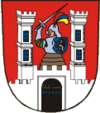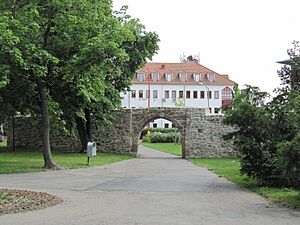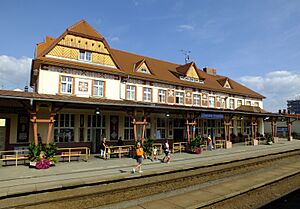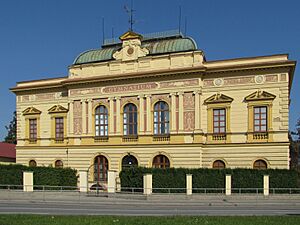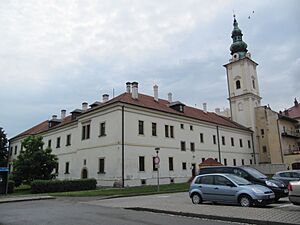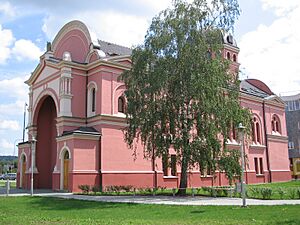Uherské Hradiště facts for kids
Quick facts for kids
Uherské Hradiště
|
|||
|---|---|---|---|
|
Town
|
|||
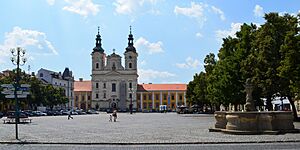
Town square with the Church of Saint Francis Xavier
|
|||
|
|||
| Country | |||
| Region | Zlín | ||
| District | Uherské Hradiště | ||
| Founded | 1257 | ||
| Area | |||
| • Total | 21.26 km2 (8.21 sq mi) | ||
| Elevation | 179 m (587 ft) | ||
| Population
(2024-01-01)
|
|||
| • Total | 24,933 | ||
| • Density | 1,172.77/km2 (3,037.4/sq mi) | ||
| Time zone | UTC+1 (CET) | ||
| • Summer (DST) | UTC+2 (CEST) | ||
| Postal codes |
686 01, 686 04 – 686 06
|
||
Uherské Hradiště is a town in the Zlín Region of the Czech Republic. It is home to about 25,000 people. If you include the nearby towns of Staré Město and Kunovice, the total population is over 37,000.
This town is the main hub for the cultural area called Moravian Slovakia. Its old town center is very well kept. It is even protected by law as a special historic area.
Contents
About Uherské Hradiště
Parts of the Town
Uherské Hradiště includes several smaller areas and villages. These are Jarošov, Mařatice, Míkovice, Rybárny, Sady, and Vésky.
What Does the Name Mean?
The name "Uherské Hradiště" means "Hungarian fortified settlement". This name shows that it was a strong place near the border of the Kingdom of Hungary.
Where is Uherské Hradiště?
Uherské Hradiště is about 23 kilometers (14 miles) southwest of Zlín. It forms a connected urban area with Staré Město and Kunovice. The town sits on the left bank of the Morava River. This river forms the northern edge of the town. A smaller river, Olšava, flows through the southern part.
A Look at History
Uherské Hradiště has a long history. In the early 800s, Slavic tribes built a settlement here. It was on three islands in the Morava River. This early settlement disappeared after the Great Moravian Empire fell.
The town we know today was founded in 1257. King Ottokar II started it. He wanted to protect a nearby monastery in Velehrad. It was first called Nový Velehrad, meaning "New Velehrad". Later, it became Hradiště. The name Uherské Hradiště was first used in 1587.
In the 1300s, stone walls were built around the town. These replaced older wooden fences. Over the years, these defenses were made even stronger. Because of its location, Uherské Hradiště often faced attacks. It was threatened by the Cumans in the 1500s. It also saw fighting during the Thirty Years' War. Turkish invasions in the 1700s also posed a threat. The town was finally captured in 1742 by the Prussian Army.
From 1644 to 1773, the Jesuits lived in the town. They helped improve the town's culture and spiritual life. They built a complex of buildings. This included a Jesuit college, the Church of Saint Francis Xavier, and a Jesuit school.
In the 1780s, Uherské Hradiště stopped being a fortress. In the mid-1800s, the town started to grow outside its walls. More buildings were constructed in the late 1800s. In the early 1900s, new factories were also built.
In 1997, Uherské Hradiště was affected by a big flood.
Population Growth
| Historical population | ||||||||||||||||||||||||||||||||||||||||||||||||||||||||
|---|---|---|---|---|---|---|---|---|---|---|---|---|---|---|---|---|---|---|---|---|---|---|---|---|---|---|---|---|---|---|---|---|---|---|---|---|---|---|---|---|---|---|---|---|---|---|---|---|---|---|---|---|---|---|---|---|
|
|
|
||||||||||||||||||||||||||||||||||||||||||||||||||||||
| Source: Censuses | ||||||||||||||||||||||||||||||||||||||||||||||||||||||||
The town's population has grown a lot over the years. In 1869, there were about 5,600 people. By 2021, the population had grown to over 25,000.
Getting Around Town
Uherské Hradiště has 8 local bus lines. There are also many regional and long-distance bus routes.
Major roads pass through the town. The I/55 road connects Olomouc to Hodonín. The I/50 road, which is part of the European route E50, goes from Brno to the Czech-Slovak border.
The town is also on important railway lines. You can take a train from Prague to Luhačovice or from Brno to Staré Město. There's also a local train line that starts here and goes to Bylnice.
Culture and Fun
Uherské Hradiště is the heart of Moravian Slovakia. This region is famous for its unique folklore, music, traditional costumes, and wine.
The town is also known for its film festival. It's called the Summer Film School (Letní filmová škola).
Learning and Education
The Uherské Hradiště Gymnasium is a very old school. It was founded on September 16, 1884. It is the oldest Czech-speaking grammar school in the Moravian Slovakia region.
Sports Teams
The town has a football club called 1. FC Slovácko. They play in the top Czech league at the Městský fotbalový stadion Miroslava Valenty. There's also an ice rink that holds 1,500 people. It's home to HC Uherské Hradiště, an ice hockey team.
Places to See
- Church of Saint Francis Xavier: This beautiful church was built between 1670 and 1685. It is a main landmark on the Masarykovo Square, the town's main square.
- Former Jesuit College: Next to the church is the old Jesuit college, built from 1654 to 1662. Today, it has a tourist information center, an art gallery, and a display about the town's history.
- Reduta: This building was once the Jesuit school (1700–1737). Now called Reduta, it is used for cultural events and social gatherings. The old Jesuit garden is now a town park.
- Franciscan Monastery: This monastery was founded in 1491. It was finished in the early 1700s. It's a very important building with beautiful rooms inside. The Church of Annunciation of the Virgin Mary is next to it.
- Moravian Slovakia Museum: This is one of the most popular museums in Moravia. It opened in 1895. One side of the museum building has a mosaic by Jano Köhler from 1905. It shows the four seasons. The museum also has an art gallery in an old armory building from the 1700s.
- Synagogue: The synagogue was built in 1875. It was rebuilt in 1904 with a new look. It was burned in 1944 but fixed after World War II. Today, this building is used as a library.
- Uherské Hradiště Railway Station: After being rebuilt in 2004, this train station won an award for "Building of the Year". In 2011, it was even chosen as the "most beautiful Czech railway station"!
Famous People from Uherské Hradiště
- Adolf Jellinek (1821–1893), a rabbi
- Božena Benešová (1873–1936), a writer and poet
- Jan Antonín Baťa (1898–1965), a businessman
- Otakar Borůvka (1899–1995), a mathematician who studied here
- Zdeněk Chalabala (1899–1962), a conductor
- Věra Suková (1931–1982), a tennis player
- Petr Nečas (born 1964), a politician and former Prime Minister
- Ladislav Kohn (born 1975), an ice hockey player
Town Partnerships
Uherské Hradiště has special partnerships with other towns around the world. These are called "twin towns" or "sister cities".
 Bridgwater, England, United Kingdom
Bridgwater, England, United Kingdom Krosno, Poland
Krosno, Poland Mayen, Germany
Mayen, Germany Sárvár, Hungary
Sárvár, Hungary Skalica, Slovakia
Skalica, Slovakia
See also
In Spanish: Uherské Hradiště para niños



